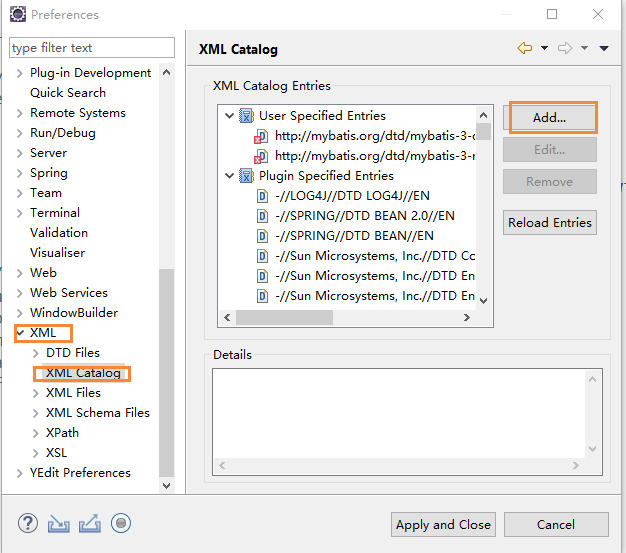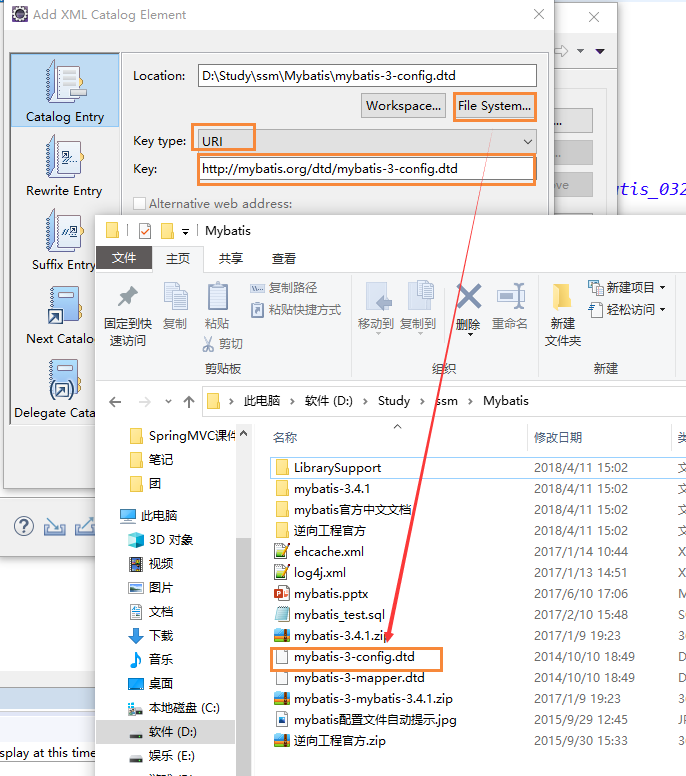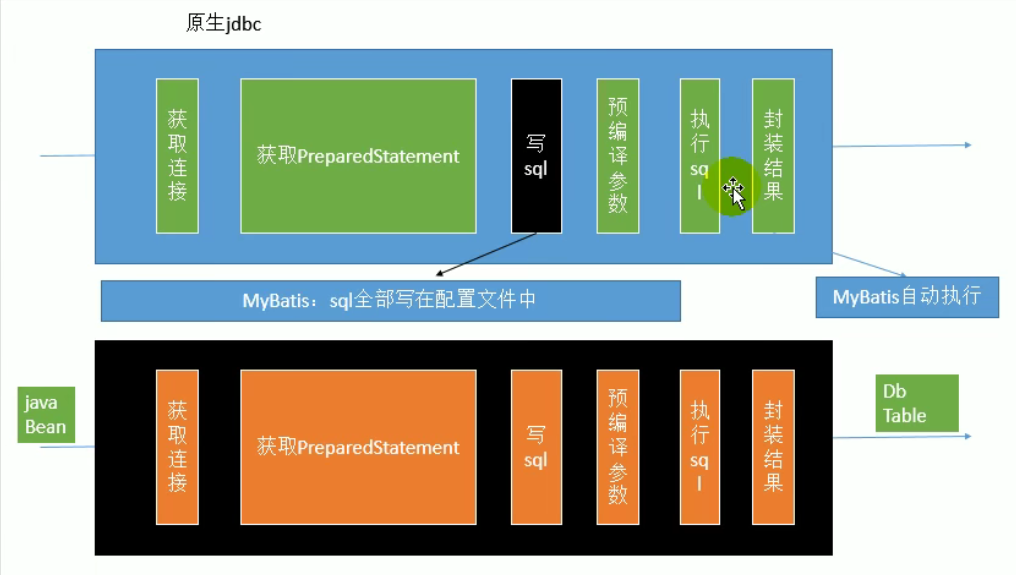官方文档:https://mybatis.org/mybatis-3/zh/index.html
1.1 MyBatis简介
MyBatis 是支持定制化 SQL、存储过程以及高级映射的优秀的持久层框架。
MyBatis 避免了几乎所有的 JDBC 代码和手动设置参数以及获取结果集。
MyBatis可以使用简单的XML或注解用于配置和原始映射,将接口和Java的POJO(Plain Old Java Objects,普通的Java对象)映射成数据库中的记录.
1、历史
原是Apache的一个开源项目iBatis, 2010年6月这个项目由Apache Software Foundation 迁移到了Google Code,随着开发团队转投Google Code旗下, iBatis3.x正式更名为MyBatis ,代码于2013年11月迁移到Github(下载地址见后)。
iBatis一词来源于“internet”和“abatis”的组合,是一个基于Java的持久层框架。 iBatis提供的持久层框架包括SQL Maps和Data Access Objects(DAO)
2、为什么要使用MyBatis?

MyBatis是一个【半自动化】的持久化层框架。
JDBC
–SQL夹在Java代码块里,耦合度高导致硬编码内伤
–维护不易且实际开发需求中sql是有变化,频繁修改的情况多见
Hibernate和JPA
–长难复杂SQL,对于Hibernate而言处理也不容易
–内部自动生产的SQL,不容易做特殊优化。
–基于全映射的全自动框架,大量字段的POJO进行部分映射时比较困难。导致数据库性能下降。
对开发人员而言,核心sql还是需要自己优化
sql和java编码分开,功能边界清晰,一个专注业务、一个专注数。
3、去哪里找MyBatis?
•https://github.com/mybatis/mybatis-3/
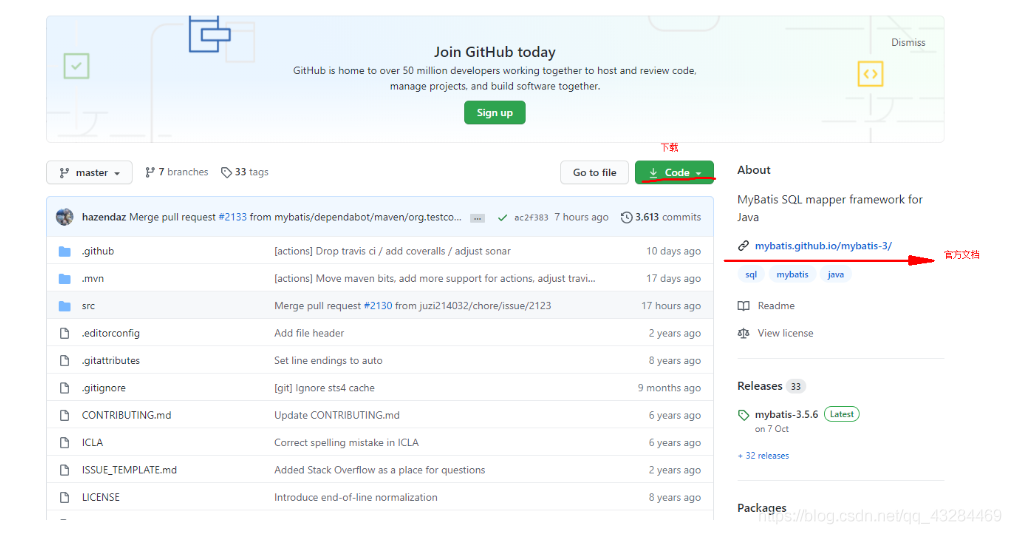
[
](https://blog.csdn.net/qq_43284469/article/details/111240140)
1.2 MyBatis-HelloWorld
1、创建一张测试表
2、创建对应的javaBean与dao接口
Employee:
public class Employee {private Integer id;private String empName;private Integer gender;private String email;//省略有参无参、get/set()、toString()}
EmployeeDao接口:
public interface EmployeeDao {//按照id查询员工public Employee getEmpById(Integer id);}
3、导包



<?xml version="1.0" encoding="UTF-8" ?><!DOCTYPE log4j:configuration SYSTEM "log4j.dtd"><log4j:configuration xmlns:log4j="http://jakarta.apache.org/log4j/"><appender name="STDOUT" class="org.apache.log4j.ConsoleAppender"><param name="Encoding" value="UTF-8" /><layout class="org.apache.log4j.PatternLayout"><param name="ConversionPattern" value="%-5p %d{MM-dd HH:mm:ss,SSS} %m (%F:%L) \n" /></layout></appender><logger name="java.sql"><level value="debug" /></logger><logger name="org.apache.ibatis"><level value="info" /></logger><root><level value="debug" /><appender-ref ref="STDOUT" /></root></log4j:configuration>
4、创建mybatis全局配置文件

mybatis-config.xml:
<?xml version="1.0" encoding="UTF-8" ?>
<!DOCTYPE configuration
PUBLIC "-//mybatis.org//DTD Config 3.0//EN"
"http://mybatis.org/dtd/mybatis-3-config.dtd">
<configuration>
<environments default="development">
<environment id="development">
<transactionManager type="JDBC"/>
<dataSource type="POOLED">
<property name="driver" value="com.mysql.jdbc.Driver"/>
<property name="url" value="jdbc:mysql://localhost:3309/mybatis_0325"/>
<property name="username" value="root"/>
<property name="password" value="123456"/>
</dataSource>
</environment>
</environments>
<mappers>
<mapper resource="EmployeeDao.xml"/>
</mappers>
</configuration>
5、创建sql映射文件
xml配置文件版的 dao接口的实现描述,
public Employee getEmpById(Integer id);
mapper标签
namespace属性:名称空间;写接口的全类名
select标签:用来定义一个查询操作
id属性:方法名;相当于对于某个方法的实现
resultType属性:方法运行后的返回值类型(查询操作必须指定)
#{属性名}:代表取出传递过来的某个参数的值
EmployeeDao.xml: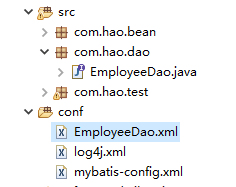
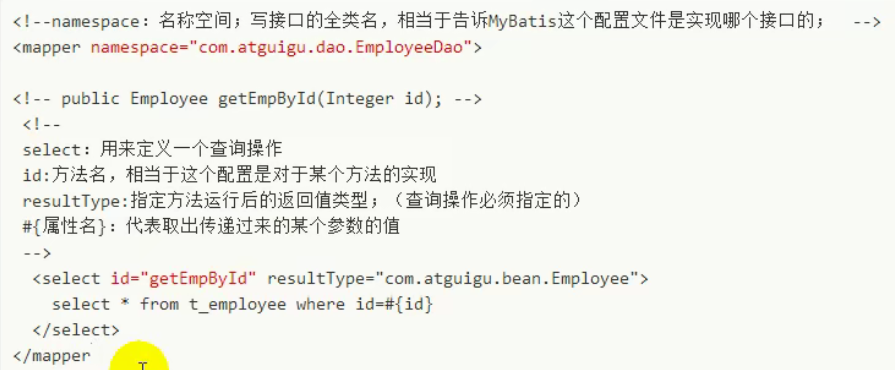
<?xml version="1.0" encoding="UTF-8" ?>
<!DOCTYPE mapper
PUBLIC "-//mybatis.org//DTD Mapper 3.0//EN"
"http://mybatis.org/dtd/mybatis-3-mapper.dtd">
<mapper namespace="com.achang.dao.EmployeeDao">
<select id="getEmpById" resultType="com.achang.bean.Employee">
select * from t_employee where id = #{id}
</select>
<!--增删改不用写返回值类型-->
<update id="updateEmp" >
update t_employee set empname = #{empName},gender = #{gender},email = #{email} where id = #{id}
</update>
<delete id="deleteEmpById">
delete from t_employee where id = #{id}
</delete>
<insert id="insertEmp">
insert into t_employee(empname,gender,email)
values(#{empName},#{gender},#{email})
</insert>
</mapper>
6、在全局配置文件注册
在mybatis_config.xml中配置:
<!--mappers标签:引入自己编写的每一个接口的xml实现文件
resource属性:引入xml实现文件的位置
-->
<mappers>
<mapper resource="EmployeeDao.xml"/>
</mappers>
在此注册让Mybatis知道我们的dao实现xml文件在哪里
7、测试

完整的查询语句测试:
@Test
public void test1() throws IOException {
//1、根据全局配置文件创建出一个sqlSessionFactory
//SqlSessionFactory:是SqlSession工厂,负责创建SqlSession对象
//SqlSession对象:sql会话---(代表和数据库的一次会话)
String resource = "mybatis_config.xml";
InputStream inputStream = Resources.getResourceAsStream(resource);
SqlSessionFactory sqlSessionFactory = new SqlSessionFactoryBuilder().build(inputStream);
Employee employee = null;
SqlSession openSession = null;
try {
//2、获取和数据库的一次会话;与getConnection();拿到一条连接
sqlSessionFactory.openSession();
//3、使用SqlSession操作数据库,获取到dao接口的实现
EmployeeDao employeeDaoImpl = openSession.getMapper(EmployeeDao.class);
//4、拿到dao接口impl实现类后,调用相对于的方法即可
employee = employeeDaoImpl.getEmpById(1);
} catch (Exception e) {
e.printStackTrace();
} finally {
openSession.close();
}
System.out.println(employee);//Employee{id=1, empName='admin', gender=0, email='admin@qq.com'}
}
增删改查语句PLUS:
注意!!!注意!!!注意!!!
增删改需要设置事务
方式一、—要在方法中最后try-catch-finally关闭资源,增删改需要手动提交事务
方式二、—openSession(true);设置是否自动提交事务,true为自动提交,false为不自动提交(例子:修改方法)
public class EmployeeTest {
//工厂在类中创建一次即可
SqlSessionFactory sqlSessionFactory;
//每次调用自动的执行,一次会话一次连接
@Before
public void initSqlSessionFactory() throws IOException {
String resource = "mybatis_config.xml";
InputStream inputStream = Resources.getResourceAsStream(resource);
sqlSessionFactory = new SqlSessionFactoryBuilder().build(inputStream);
}
//查询
@Test
public void test1() throws IOException {
SqlSession sqlSession = sqlSessionFactory.openSession();
EmployeeDao mapper = sqlSession.getMapper(EmployeeDao.class);
Employee empById = mapper.getEmpById(3);
System.out.println(empById);
}
//修改
@Test
public void test2() throws IOException {
//openSession(true)设置自动提交事务
SqlSession sqlSession = sqlSessionFactory.openSession(true);
int updateEmp = 0;
try {
EmployeeDao mapper = sqlSession.getMapper(EmployeeDao.class);
updateEmp = mapper.updateEmp(new Employee(3, "欧尼", 1, "achang@qq.com"));
} catch (Exception e) {
e.printStackTrace();
} finally {
sqlSession.close();
}
System.out.println(updateEmp);
}
//新增
@Test
public void test3() throws IOException {
SqlSession sqlSession = sqlSessionFactory.openSession();
int insertEmp = 0;
try {
EmployeeDao mapper = sqlSession.getMapper(EmployeeDao.class);
insertEmp = mapper.insertEmp(new Employee(null, "我我", 0, "sisi@qq.com"));
} catch (Exception e) {
e.printStackTrace();
} finally {
sqlSession.commit();
sqlSession.close();
}
System.out.println(insertEmp);
}
//删除
@Test
public void test4() throws IOException {
SqlSession sqlSession = sqlSessionFactory.openSession();
boolean empById = false;
try {
EmployeeDao mapper = sqlSession.getMapper(EmployeeDao.class);
empById = mapper.deleteEmpById(8);
} catch (Exception e) {
e.printStackTrace();
} finally {
sqlSession.commit();
sqlSession.close();
}
System.out.println(empById);
}
}
8、细节
两个文件:
1、全局配置文件:mybatis-config.xml;指导mybatis正确运行的一些全局设置
2、SQL映射文件:EmployeeDao.xml;相当于是对Dao接口的一个实现描述细节;
细节:
1、获取到的是接口的代理对象;mybatis自动创建的
2、SqlSessionFactory和SqlSession;
SqlSessionFactory:创建SqlSession对象,Factory只new一次就行
SqlSession:相当于connection,是和数据库进行交互的,也是一次和数据库的一次会话,就应该创建一个新的的SqlSession,一次与数据库连接,就创建一次会话
[
](https://blog.csdn.net/qq_43284469/article/details/111240140)
1.3 导入dtd写xml有提示
方法一: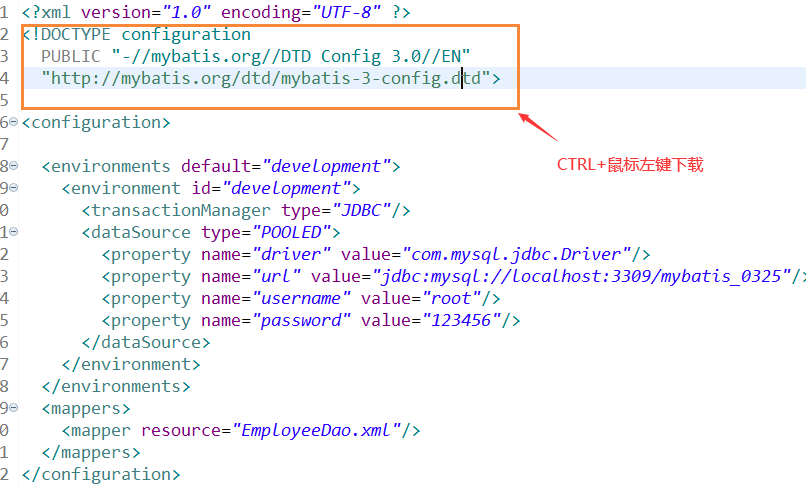
方法二:
复制dtd的引用网址:http://mybatis.org/dtd/mybatis-3-config.dtd